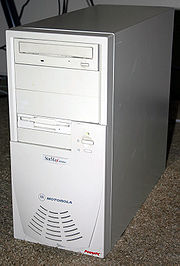
Motorola StarMax
Encyclopedia

Motorola
Motorola, Inc. was an American multinational telecommunications company based in Schaumburg, Illinois, which was eventually divided into two independent public companies, Motorola Mobility and Motorola Solutions on January 4, 2011, after losing $4.3 billion from 2007 to 2009...
in 1996 and 1997. They used versions of Apple's
Apple Computer
Apple Inc. is an American multinational corporation that designs and markets consumer electronics, computer software, and personal computers. The company's best-known hardware products include the Macintosh line of computers, the iPod, the iPhone and the iPad...
Tanzania motherboard
Motherboard
In personal computers, a motherboard is the central printed circuit board in many modern computers and holds many of the crucial components of the system, providing connectors for other peripherals. The motherboard is sometimes alternatively known as the mainboard, system board, or, on Apple...
, which was designed to use standard IBM PC compatible
IBM PC compatible
IBM PC compatible computers are those generally similar to the original IBM PC, XT, and AT. Such computers used to be referred to as PC clones, or IBM clones since they almost exactly duplicated all the significant features of the PC architecture, facilitated by various manufacturers' ability to...
components in addition to Apple-proprietary
Proprietary hardware
Proprietary hardware is computer hardware which is owned by the proprietor.Historically, most early computer hardware was designed as proprietary until the 1980s, when IBM PC changed this paradigm...
components then in common use in the Power Macintosh
Power Macintosh
Power Macintosh, later Power Mac, was a line of Apple Macintosh workstation-class personal computers based on various models of PowerPC microprocessors that were developed, marketed, and supported by Apple Inc. from March 1994 until August 2006. The first models were the Power Macintosh 6100,...
family. They featured SVGA video ports rather than the proprietary port Apple used at the time, and PS/2
PS/2 connector
The PS/2 connector is a 6-pin Mini-DIN connector used for connecting some keyboards and mice to a PC compatible computer system. Its name comes from the IBM Personal System/2 series of personal computers, with which it was introduced in 1987...
mouse and keyboard ports in addition to ADB
Apple Desktop Bus
Apple Desktop Bus is an obsolete bit-serial computer bus connecting low-speed devices to computers. Used primarily on the Macintosh platform, ADB equipment is still available but not supported by most Apple hardware manufactured since 1999....
. The motherboard was also capable of using manual-eject floppy drives
Floppy disk
A floppy disk is a disk storage medium composed of a disk of thin and flexible magnetic storage medium, sealed in a rectangular plastic carrier lined with fabric that removes dust particles...
, though Motorola disabled this functionality and shipped the computers with software-eject drives.
The StarMax line was discontinued after Apple terminated the Macintosh clone license program in 1997.
Product Line
The StarMax was sold in four different product lines. In addition, the StarMax 6000, based on the PowerPC 750 processor was announced, but never shipped due to the termination of the Macintosh clone program. It would have been available several months before Apple released the Power Macintosh G3Power Macintosh G3
The Power Macintosh G3, commonly called "beige G3s" or "platinum G3s" for the color of their cases, was a series of personal computers designed, manufactured, and sold by Apple Computer, Inc. from November 1997 to January 1999...
.
StarMax models numbers were derived using a standard system: (product line)/(CPU speed)(case type)
- product line was 3000, 4000, 5000, or 5500 and designated the CPU used in the machine
- 3000 and 5000 used PowerPC 603e processors
- 4000 and 5500 used PowerPC 604e processors.
- cpu speed was the processor's clock speed, in megahertz
- case type was either DT or MT and designated the type of case used
- DT was a desktop case suitable for placing under a monitor
- MT was a minitower case
5000 and 5500 models used an upgraded "Tanzania II" logic board featuring faster system bus speeds and improved integrated graphics based on the ATI 3D RAGE II+
ATI Rage
The ATI Rage is a series of graphics chipsets offering GUI 2D acceleration, video acceleration, and 3D acceleration. It is the successor to the Mach series of 2D accelerators.-3D RAGE :...
chip.
External links
- Low End Mac Motorola StarMax page
- StarMax-talk YahooGroup

